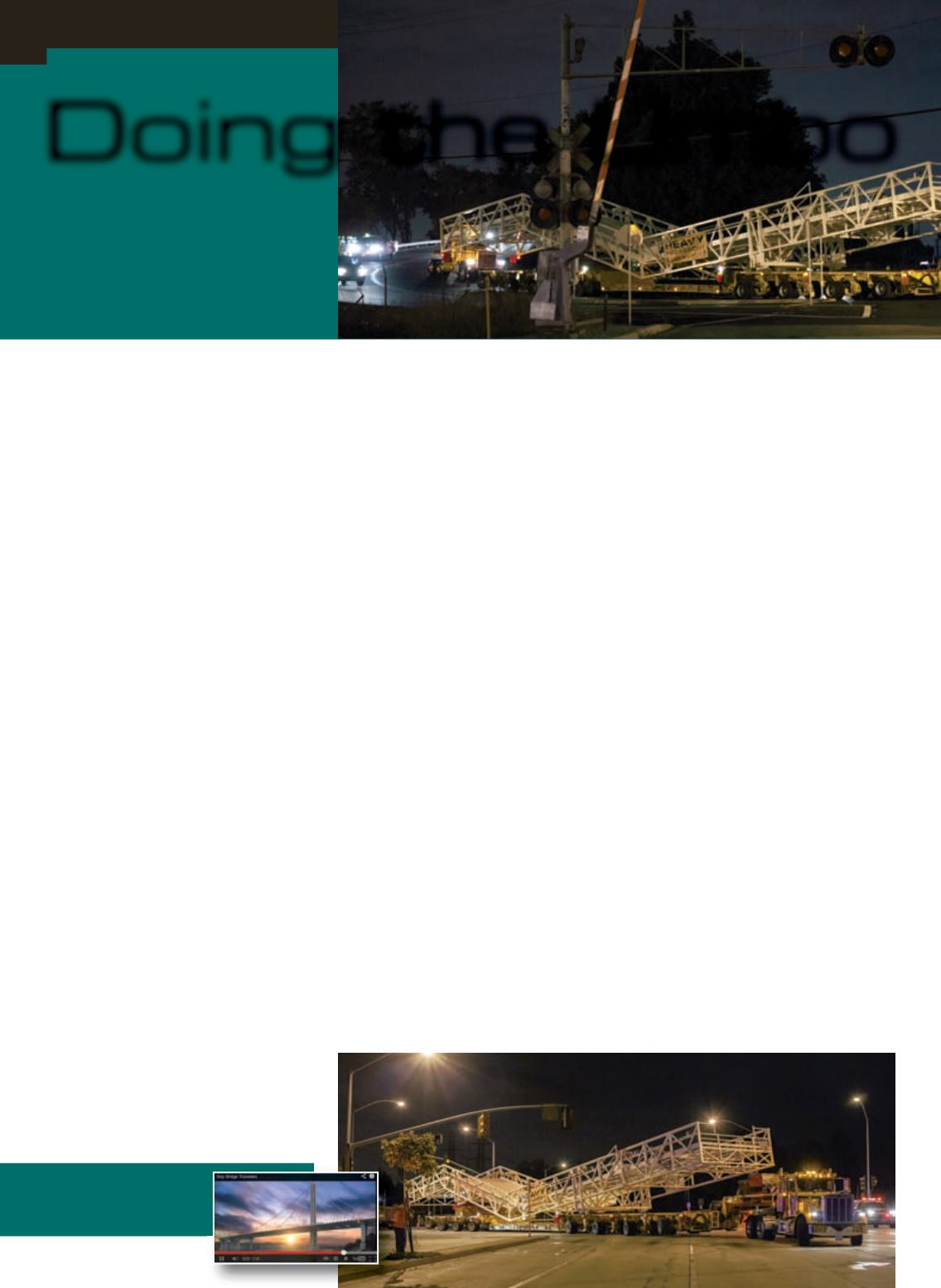
48
ACT
OCTOBER 2013
Complicated route
But before the travelers were installed,
they had to first travel from the Westmont
Industries plant in Santa Fe Springs, CA,
where they were fabricated, to the Port
of Long Beach, from where they were
barged to Oakland. It would be the most
challenging movement these travelers ever
made. Because of the complexity of the
transport, only a handful of companies in
the world could accomplish this feat – or
even dare to undertake it.
Fortunately, one of these companies was
located near the manufacturer – Heavy
Transport, one of the Bragg Companies of
Long Beach. For more than 65 years, the
family-owned business has specialized in
over-sized, multi-dimensional and super-
load hauling, providing a full-service
approach to individualized transportation
needs. Even for Heavy Transport, this
would be a very demanding job that
required 1,700 planning hours over the
course of a year. Much of this time was
spent coordinating the efforts of those
involved with the travelers’ fabrication,
hauling, permitting and escorting and
barging of the five sections. Regulatory
approvals came from the Caltrans, the
California Highway Patrol (CHP), and five
cities and counties.
The largest of these parts measured
119-feet-long by 19-feet-tall by 16-feet,
4-inches-wide and weighed 51,000
pounds. Loaded, the dimensions jumped
to 180-feet-long by 19-feet-tall by 19-feet
high and a net weight of 70,000 pounds.
O
n September 3, traffic began
moving across the new East
Span of the San Francisco-
akland Bay Bridge. Stretching 2,047 feet,
the Self-Anchored Suspension (SAS) span
is the signature element of the bridge and
the world’s longest such span.
The single, nearly mile-long main cable
now supports the 35,200-ton decks of the
bridge. The bridge’s single 525-foot-tall
tower echoes the height of the West Span’s
towers. Unlike traditional suspension
bridges where the cables are anchored
into the ground, an SAS bridge’s cable is
anchored in the roadways.
Through ingenious engineering, the span
was constructed to last 150 years, more
than double that of any other traditional
bridge. Moreover, the span was designed
to withstand high winds, as well as the
largest possible earthquake that may occur
with the next 1,500 years.
Such longevity requires regular bridge
maintenance. Five moving scaffolds,
known as “travelers,” have been
suspended from tracks beneath the
bridge, providing safe access to workers,
who will conduct bridge inspections,
repairs and painting operations. The
design of the travelers also enables them
to capture maintenance-related debris
such as paint chips and dust, water,
sandblasting grit and paint overspray,
preventing this material from falling into
the bay 150 feet below.
The travelers, which move by pneumatic
power from air compressors located in
Oakland and on Yerba Buena Island, will
carry crews laterally underneath the bridge
at a rate of 20 feet per minute heading west
and 50 feet per minute heading east. They
allow personnel to complete the work as
safely and efficiently as possible.
Even the smallest of the travelers, a
15-1/2-foot-wide bike and pedestrian
path, called for a tricky transport.
The unique load structure of the
travelers required the use of Heavy
Transport’s Scheuerle Wide-Combi trailers
with two 4-axle sections and a 39-foot
drop deck insert to keep the height of the
Traveler sections as low as possible while
being hauled down city streets in Santa
Fe Springs and Long Beach. The trailer
configuration also needed a rigid support
to keep the load’s structure from twisting
while also keeping it supported and
tied down in four places on engineered
mounting points. A custom-built heavy-
haul Peterbilt tractor pulled each load.
For enhanced maneuverability, the eight
sets of tires could articulate 60 degrees and
move up and down. The Bay Bridge Public
Information Office characterized these
movements as “a giant game of steel doing
the Limbo.”
Zigging and zagging
Although the distance between the point
of manufacture and the Port of Long
Beach was about 20 miles, most freeways
and city streets could not accommodate
the load. Each piece had to be hauled on
a complicated, zig-zag route with 21 turns
that stretched 50 miles. Heavy Transport
coordinated with its bucket truck service
and CHP escorts to protect power lines,
signals, trees and other obstructions.
California requires such variance loads to
be moved at night.
Doing the Limbo
Heavy Transport uses virtually every inch of both
sides of the road to avoid overhead obstacles.
Terry White
chronicles how
Heavy Transport hauled the
Bay Bridge travelers.
To view an online
video of the job, visit:
SITE REPORT
TRANSPORT


